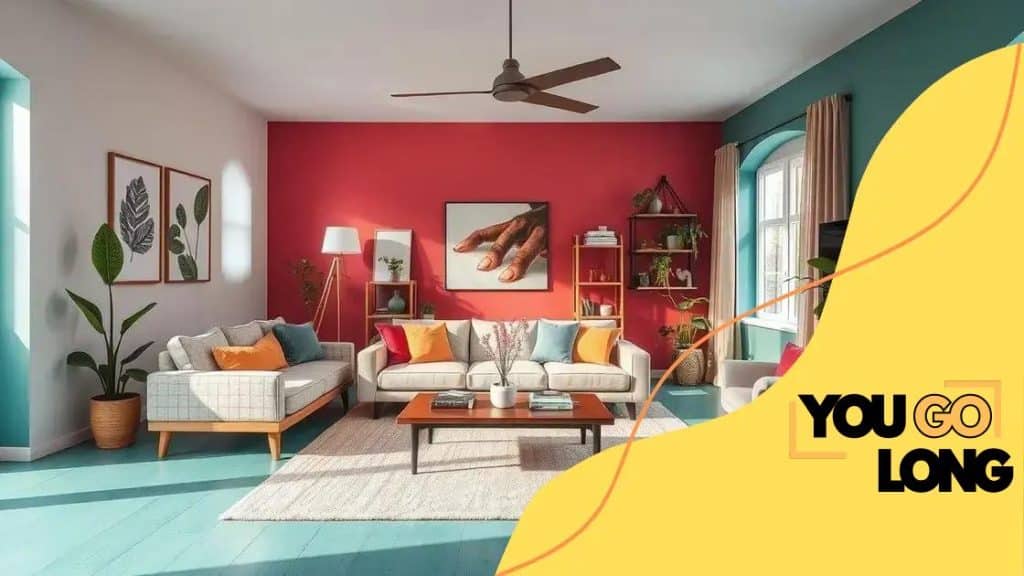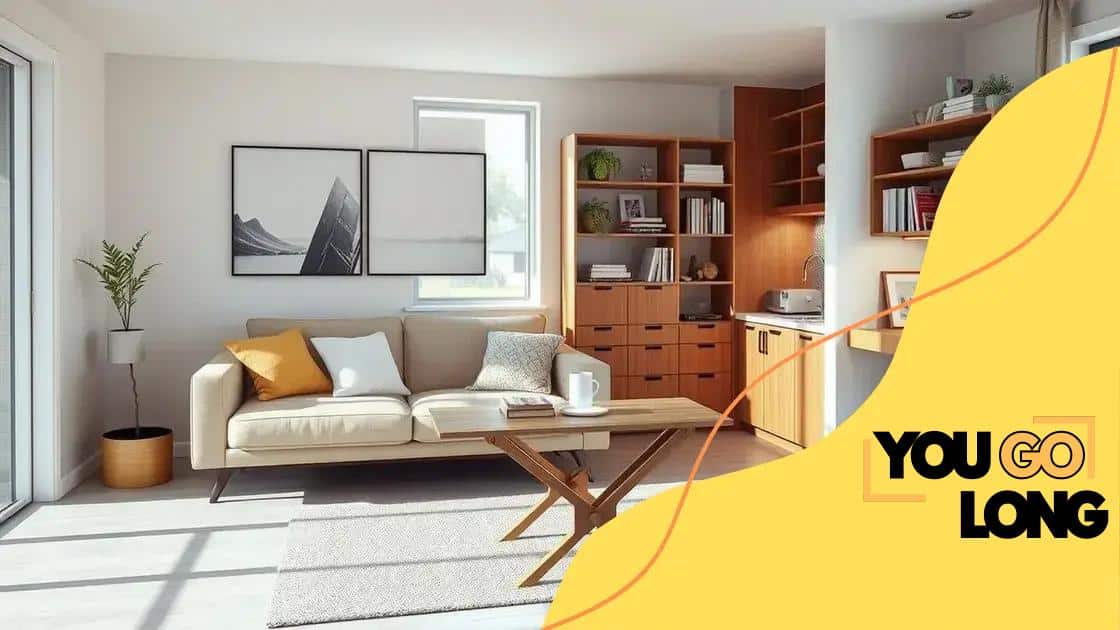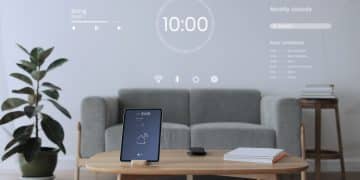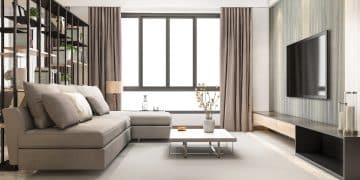Interior design trends in home decoration for 2025

Advertisement
Interior design trends in home decoration for 2025 emphasize bold colors, multi-functional spaces, sustainable materials, biophilic design, and smart technology integration to create stylish and functional environments that enhance well-being and connectivity with nature.
Interior design trends in home decoration for 2025 offer exciting possibilities to refresh your home. Have you ever wondered how the latest styles can transform your space into something extraordinary? Let’s explore what’s ahead in the world of home decor.
Bold colors making a statement
In the realm of interior design, incorporating bold colors can drastically change the look and feel of a space. By utilizing vibrant hues, homeowners can express their personal style and create an inviting atmosphere that resonates with visitors.
Bolder is Better: Using daring shades invites creativity and energy into your home. Instead of muted tones, think about how deep greens or vivid blues can create a statement wall. Paint isn’t the only way to celebrate colors; consider your furniture and decor elements, too.
Advertisement
Color Combinations to Try
Combining different colors can be just as impactful. Whether you’re creating a dramatic effect or a harmonious environment, pairing colors is key. Popular combinations include:
- Blue and yellow for a fresh, cheerful vibe.
- Dark green with gold accents for a luxurious feel.
- Rich red with soft gray for an elegant contrast.
Each combination offers unique attributes that can transform a room. Additionally, consider how natural light affects color perception. Rooms with plenty of sunlight can handle bolder shades without overwhelming the senses.
Accent pieces such as cushions, artwork, or rugs can also enhance the boldness of your design. By mixing and matching these components, you can achieve a dynamic look that captures attention without being too overpowering. A well-placed vibrant pillow or a colorful painting can be the perfect finishing touch.
Advertisement
Furthermore, integrating bold colors doesn’t have to be intimidating. Start small by introducing one bright element into a neutral space. As you grow more comfortable, you can add more daring colors to truly personalize your environment.
Remember, the goal is to showcase your individuality while creating a space that feels cohesive and comfortable. Embrace bold colors as a way to make a statement that reflects who you are.
Sustainable materials and practices
As we move towards greater environmental consciousness, sustainable materials and practices in interior design are becoming increasingly important. These choices not only benefit the planet but also enhance the aesthetic appeal of your home.
Using materials that are eco-friendly can have a positive impact. Reclaimed wood, for instance, is a fantastic option. It offers unique character while reducing waste in landfills. Similarly, bamboo is a renewable resource that is durable and stylish.
Types of Sustainable Materials
When designing your space, consider these sustainable materials:
- Recycled Metal: Ideal for fixtures and decor, it reduces the need for new production.
- Natural Fibers: Cotton, jute, and wool are perfect for textiles, providing comfort and sustainability.
- Low-VOC Paints: These paints help maintain indoor air quality, promoting a healthier home.
Adopting sustainable practices goes beyond materials. Consider your sourcing practices. Choose local suppliers to reduce transportation emissions and support your community. This not only promotes a healthier environment but also adds a personal touch to your decor.
Throughout your design journey, think about energy efficiency as well. Opting for energy-efficient appliances and LED lighting can significantly cut down on energy consumption. With these choices, your home becomes not just a stylistic statement but also an environmentally responsible one.
Incorporating sustainability in design is about making thoughtful choices. As you proceed, keep in mind how every aspect of your design can reflect a commitment to protecting our planet while still being stylish and functional.
Multi-functional spaces for modern living

In today’s fast-paced world, multi-functional spaces have become essential in modern living. These versatile areas adapt to various needs, maximizing utility and comfort in homes.
Creating a multi-functional space means rethinking how you use your rooms. For instance, a living area can serve as both a gathering spot and a workspace. By integrating smart furniture, such as a sofa bed or a foldable desk, you can transform any room based on the time of day or your current activities.
Key Features of Multi-functional Spaces
Consider incorporating these elements into your design:
- Flexible Furniture: Look for pieces that can easily change function. Ottomans with storage or modular sofas are great choices.
- Open Layouts: An open floor plan can enhance mobility and visibility, creating a seamless flow between spaces.
- Smart Technology: Home automation can help manage different activities within a single area, such as lighting and sound systems.
Additionally, think about how zoning can help define different areas within a single space. Using rugs or furniture arrangement can separate a cozy reading nook from a home office setup. This way, you can enjoy diverse activities without feeling cluttered or distracted.
Natural light plays a vital role in multi-functional spaces. Large windows or glass doors can make the area feel more spacious and inviting. Using light colors on the walls can also help create an airy feel, perfect for areas where you need to switch from relaxation to focus quickly.
Ultimately, designing multi-functional spaces is about making your home work for you. By considering your lifestyle and how you want to use each area, you can create a harmonious environment that meets all your needs.
The rise of biophilic design
Biophilic design is becoming increasingly popular in interior spaces as people seek a stronger connection with nature. This approach emphasizes incorporating natural elements into our living and working environments, promoting well-being and enhancing the aesthetic appeal.
Bringing nature indoors can be done in various ways. One effective method is through the use of plants. Adding greenery not only beautifies a space but also improves air quality. Indoor plants like snake plants and pothos are easy to care for and can thrive in different light conditions, making them perfect for any room.
Key Elements of Biophilic Design
When considering biophilic design, pay attention to these important elements:
- Natural Light: Maximize natural daylight through large windows and skylights. Light can refresh and energize a space.
- Natural Materials: Use materials like wood, stone, and bamboo to enhance a connection with nature. These elements can create a warm, inviting atmosphere.
- Water Features: Incorporating water elements like fountains or aquariums can add tranquility and a soothing environment.
Besides physical elements, the arrangement of space plays a key role in biophilic design. Open spaces that mimic natural landscapes allow for movement and interaction. Using organic shapes and forms in furniture and architecture can enhance this feeling further.
Biophilic design also extends to color. Earthy tones, such as greens, browns, and blues, can evoke a sense of nature and calmness. When you choose your color palette, think about how these shades can reflect the outdoor environment within your home.
Over time, adopting biophilic design not only creates a more pleasant space but also supports mental health. People often feel more relaxed and creative in environments where nature is present. Therefore, incorporating biophilic elements can contribute positively to your overall well-being.
Tech integration in home interiors
As technology continues to advance, tech integration in home interiors has become a major trend in modern design. Homeowners are embracing smart devices that enhance comfort, security, and convenience in their living spaces.
A key aspect of tech integration is the rise of smart home systems. These systems allow for seamless control of various functions through a single interface, typically via a smartphone or a voice assistant. You can control lighting, temperature, and even entertainment systems with simple commands, making daily life easier and more efficient.
Popular Smart Home Features
Several gadgets are leading the charge in tech integration:
- Smart Speakers: Devices like Amazon Echo and Google Home can play music, set reminders, and control other smart devices.
- Smart Thermostats: These devices learn your heating and cooling preferences, saving energy and lowering utility bills.
- Smart Security Systems: With cameras and alarms that you can monitor remotely, you can enhance your home security effortlessly.
Incorporating this technology doesn’t just provide ease; it also enhances your home’s aesthetic. Many smart devices are designed to blend seamlessly into your decor, offering style without compromising functionality. For example, wall-mounted control panels can be sleek and minimally invasive, allowing homeowners to maintain a clean look.
Moreover, integrating technology extends beyond gadgets. Built-in charging stations, automated blinds, and ambient lighting can create a more efficient and enjoyable space. Think about how creating zones with different lighting options can set the mood for various activities, from enjoying a movie night to hosting a dinner party.
As technology evolves, the possibilities for integration into home design will only grow. This trend not only makes life more enjoyable but also increases the overall value of your home. The goal is to create a cohesive environment where technology enhances your lifestyle, making your home smarter and more responsive to your needs.
FAQ – Frequently Asked Questions about Interior Design Trends in 2025
What are some benefits of incorporating bold colors in home design?
Bold colors can create a vibrant atmosphere, express personal style, and enhance the overall aesthetic appeal of your home.
How can I make my small space multi-functional?
You can use furniture that serves multiple purposes, such as sofa beds, folding tables, and storage ottomans, to maximize the usability of your space.
What is biophilic design and why is it important?
Biophilic design focuses on connecting with nature through natural elements like plants and light, promoting well-being and a calming environment.
How can technology improve my home’s interior design?
Integrating smart home devices can enhance convenience, energy efficiency, and overall functionality, making your home more responsive to your lifestyle.





